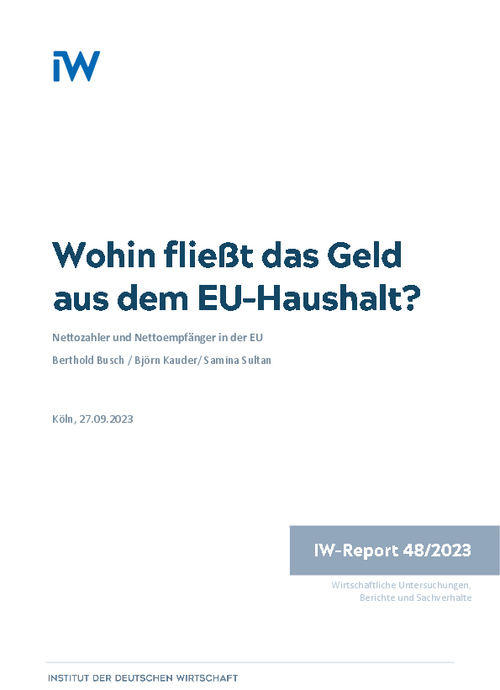Germany's net position in 2022 is slightly down on the previous year, from €21.4 billion to €19.7 billion euros, but it is still significantly higher than in the pre-Brexit period. On average for 2014 to 2020, the last Multiannual Financial Framework, it was €13.5 billion euros.

Where does the money from the EU budget go?: Net contributors and net recipients in the EU

Germany's net position in 2022 is slightly down on the previous year, from €21.4 billion to €19.7 billion euros, but it is still significantly higher than in the pre-Brexit period. On average for 2014 to 2020, the last Multiannual Financial Framework, it was €13.5 billion euros.
Germany thus remains the largest net contributor, ahead of France, which last year paid out €10.0 billion euros more than it received in returns. Italy ranks third with a net contribution of 3.9 billion euros. As in the previous year, Poland is the largest net recipient with 11.9 billion euros (2021: 12.9 billion euros). Romania and Hungary are far behind with 5.6 and 4.4 billion euros respectively.
Calculated per capita and in relation to gross national income (GNI), Germany remains the largest net contributor. However, there have been significant changes in the net recipients. Per capita and as a percentage of GNI, the Baltic states, among others, can benefit from financial relations with the EU budget.
The decomposition of the total net position into sub-balances shows which member states benefit most financially from agricultural and cohesion policy. According to this calculation, the largest net beneficiary of agricultural policy is Greece with 1.07 per cent of GNI. Other weighty net recipients of the EU agricultural budget are Bulgaria and Lithuania. Latvia and Hungary are the fourth and fifth largest net recipients from the agricultural budget.
The largest net recipient of cohesion spending is Hungary with 1.92 per cent of GNI. Slovakia is second with 1.88 per cent of GNI. Latvia is again among the top 5 net recipients, at 1.69 per-cent of GNI, followed by Estonia (1.65 per cent) and Lithuania (1.53 per cent). It seems consistent that the newer eastern EU member states are the main beneficiaries of cohesion spending, as the aim of cohesion policy is to support the more disadvantaged regions in the EU.
The analysis is extended to include the financial flows under NGEU because it is a significant secondary budget that is also financed through an unprecedented dimension of EU borrowing.

Where does the money from the EU budget go?: Net contributors and net recipients in the EU

More on the topic
![[Translate to English:] Das Gebäude des Weißen Hauses in Washington, D.C. in den Vereinigten Staaten von Amerika. [Translate to English:] Das Gebäude des Weißen Hauses in Washington, D.C. in den Vereinigten Staaten von Amerika.](/fileadmin/_processed_/c/1/csm_GettyImages-2161499385_White_House_Editorial_884306add8.jpg)
Trump or Harris or ...? What Europe must prepare for
A few months before the presidential election in the USA, Donald Trump has a good chance of being re-elected. On the Democratic side, the incumbent president has withdrawn his candidacy after a long period of hesitation, while Vice President Kamala Harris is ...
IW
Compendium 5.5: CO2 Regulation of Road Transport in Europe
With the Compendium CO2 Regulation in Europe, the IW has been providing the interested public with a comprehensive collection of data on the development of CO2 emissions from passenger car traffic in the European Union, as well as on the applicable regulatory ...
IW